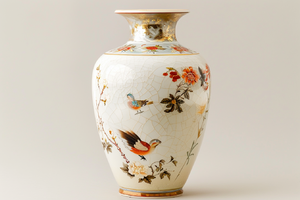Satsuma ware

Satsuma ware (薩摩焼, Satsuma-yaki) is a distinctive style of Japanese pottery that originated in the Satsuma Province (modern-day Kagoshima Prefecture) in southern Kyushu. It is particularly famous for its finely crackled cream-colored glaze and ornate decorations, often featuring gold and polychrome enamels. Satsuma ware is highly regarded both in Japan and internationally, especially for its decorative qualities and rich historical associations.
History
Origins (16th–17th Century)
Satsuma ware traces its origins to the late 16th century, following the Japanese invasions of Korea (1592–1598). After the campaigns, the warlord Shimazu Yoshihiro brought skilled Korean potters to Satsuma, who established the foundations of the local ceramics tradition.
Early Satsuma (Shiro Satsuma)
The earliest form, often called Shiro Satsuma (white Satsuma), was made using local clay and fired at low temperatures. It was simple, rustic, and usually left undecorated or lightly painted. These early wares were used for everyday purposes and tea ceremonies.
Edo Period (1603–1868)
Over time, Satsuma ware gained aristocratic patronage, and the pottery became more refined. Workshops in Kagoshima, notably in Naeshirogawa, began producing increasingly elaborate pieces for the Daimyō and the upper classes.
Meiji Period (1868–1912)
During the Meiji era, Satsuma ware underwent a transformation, adapting to Western tastes. Pieces were richly decorated with:
- Gold and colored enamels
- Scenes of Japanese life, religion, and landscapes
- Elaborate borders and patterns
This period saw a dramatic rise in Satsuma ware's export to Europe and America, where it became a symbol of exotic luxury.
Characteristics
Satsuma ware is distinguished by several key features:
Body and Glaze
- Clay: Soft, ivory-toned stoneware
- Glaze: Creamy, often translucent with a fine crackle pattern (kannyu)
- Feel: Delicate and smooth to the touch
Decoration
Decorative motifs are applied using overglaze enamels and gilding, frequently portraying:
- Religious subjects: Buddhist deities, monks, temples
- Nature: Flowers (especially chrysanthemums and peonies), birds, butterflies
- Genre scenes: Samurai, court ladies, children at play
- Mythological themes: Dragons, phoenixes, folklore
Forms
Common forms include:
- Vases
- Bowls
- Tea sets
- Figurines
- Decorative plaques
Types of Satsuma Ware
Shiro Satsuma (白薩摩)
- Early, cream-colored wares
- Produced primarily for domestic use
Kuro Satsuma (黒薩摩)
- Less common
- Made with darker clay and glazes
- Simpler decoration, sometimes incised or with ash glaze
Export Satsuma
- Heavily decorated with gold and color
- Created primarily for export markets (late Edo to Meiji period)
- Often signed by individual artists or studios
Notable Kilns and Artists
- Naeshirogawa Kilns (苗代川窯): The birthplace of Satsuma ware
- Yabu Meizan (藪明山): One of the most renowned Meiji-era decorators
- Kinkozan family (錦光山家): Famous for their refined technique and prolific output
Marks and Authentication
Satsuma pieces often carry marks on the base, including:
- The cross within a circle (Shimazu family crest)
- Kanji signatures of artists or workshops
- “Dai Nippon” (大日本), indicating Meiji-era patriotic pride
Note: Due to its popularity, many reproductions and fakes exist. Authentic antique Satsuma ware is typically lightweight, has an ivory glaze with fine crackles, and exhibits meticulous hand-painted detail.
Cultural Significance
Satsuma ware has played an important role in Japan's decorative arts, especially in:
- The Tea Ceremony: Early wares used as tea bowls and incense containers
- Export and Diplomacy: Served as an important cultural export during Japan’s modernization
- Collectors' Circles: Highly prized by collectors of Japanese art globally
Audio
| Language | Audio |
|---|---|
| English |
